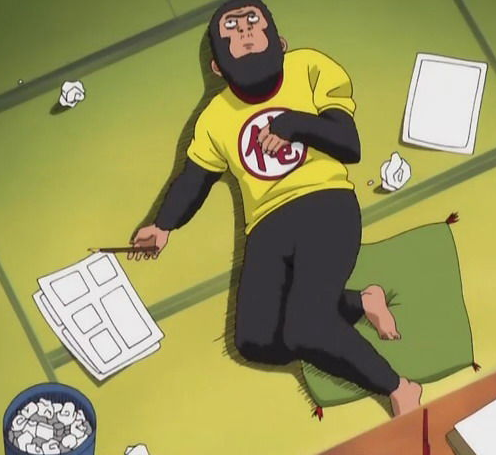
This habit has allowed Gintama to engender a massive cast of characters with both comedic and tragic attributes. Many arcs and even standalone episodes can revolve around an initially comical character who turns out to have sympathetic circumstances. This treatment isn't just limited to main characters even side characters or even characters that have only appeared in the background can turn out to have sincere motivations or tragic backstories that change the audience's perspective of them. This contrast between the two sides of each character leads the audience to hidden depths in each and every cast member in the series. Since many of these characters are often introduced and established in comedic situations, the audience is often unprepared for such an unexpected show of sincere emotion. However, Sorachi seems to have a knack for taking these goofy characters and giving them intensely emotional and often tragic backstories or placing them in serious stories where they can show off their more admirable aspects. If Gintama was just about goofy characters getting into compromising situations, it would most likely never be as popular as it currently is. RELATED: Anime That Are Better Than The Manga Hidden Depths These comedy sequences serve to define the massive cast of characters for the audience in a way that puts their main personality traits on display.

Katsura is scatterbrained or Otae has a short temper). This leads viewers to create an image of the character in their minds based on what they've seen (i. These segments reveal a lot about each character, whether it be their weird fetishes or their bizarre idiosyncrasies, and makes them clear to the audience. While these scenes are obviously very hilarious, they also have a very important purpose, especially when it comes to introducing and defining these characters. The end result is a side-splitting segment that spirals out of control due to the nonsensical actions of the main cast. Furthermore, each and every member of the cast has one or two bizarre personality traits that often help to escalate these absurd circumstances to unbelievable lengths, such as Kondo's stalker tendencies or Sacchan's flagrant masochism. Sorachi seems to relish in putting his massive cast of characters in unfortunate and embarrassing positions, and even main characters like Gintoki and cool action hero types like Hijikata and Okita can't avoid being the butt of the joke. By contrast, Gintama seems to be an example of the complete opposite.

They want them to be considered cool and inspiring, and they want their audience to look up to them. Many writers and authors are often afraid of making their characters look like fools. RELATED: Best Times Gintama Referenced Other Anime Hilarity As Characterization Gintama is a rare show that can combine laugh-out-loud comedy with dramatic tragedy, and it does it extremely well. However, that hasn't stopped it from also having its heartwarming, tear-jerking, and tragic moments as well.
#Gintama author series#
Gintama has gained a reputation for being one of the funniest manga and anime series in recent history, with tons of raunchy gags, gross humor, and blatant parody.

As they perform work as odd-jobbers, they come into contact with a variety of colorful characters and become involved in a number of outlandish events.

The three of them live in a version of 19th-century Edo, which has become abnormally technologically advanced thanks to the occupation of the Amanto. It follows the adventures of Gintoki Sakata, a former Joi patriot fighting against the alien Amanto invasion, now living as a broke freelancer doing odd-jobs with his friends and co-workers Shinpachi Shimura and Kagura. Gintama is a comedy manga series written by Hideaki Sorachi and published in Weekly Shonen Jump between the years 2003 to 2018.


 0 kommentar(er)
0 kommentar(er)
